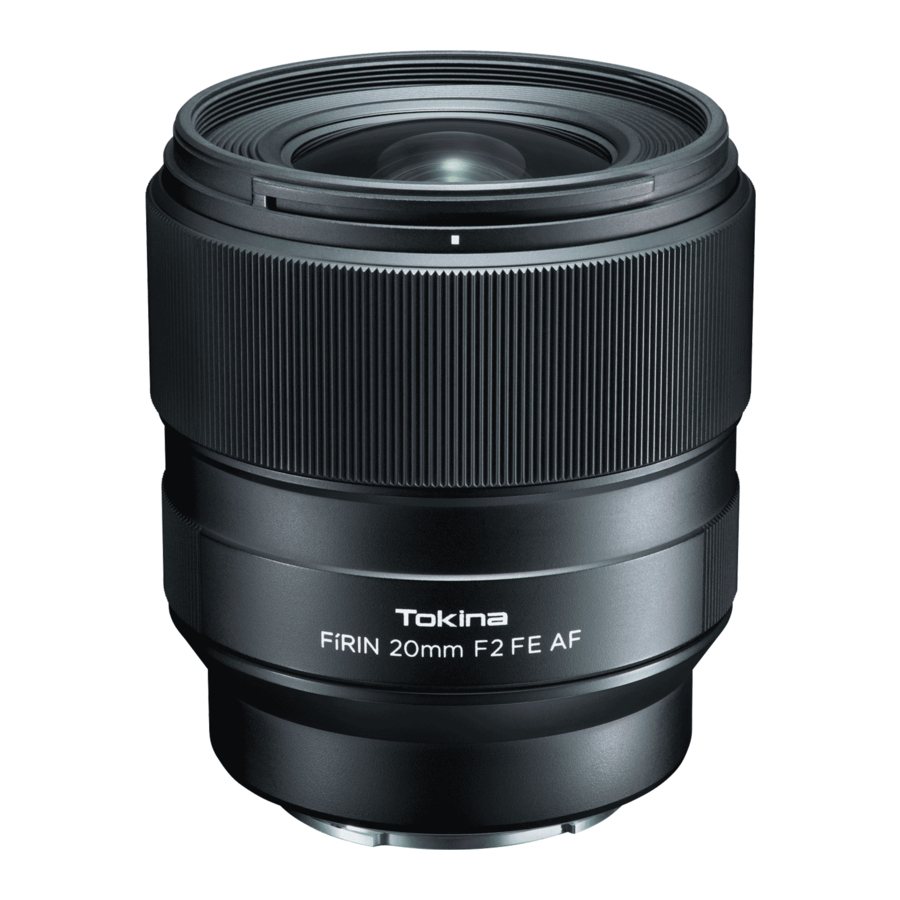Advertisement

Part names

- Center mark and hood attachment mark
- Focus ring
- Lens holding grip
- Mount attachment mark
- Mount
- Lens signal contact *
* Please do not touch directly with hands.
How to attach and remove lens
Please follow the camera instruction manual for attaching and removing the lens.
* Take care to not touch or hit electrical contacts on the mounting face of the lens while attaching or removing.
Focusing
Focusing via auto-focus
Please use your camera with its focus mode set to auto-focus.
The camera will auto-focus when you half press down the shutter button.
This lens is equipped with a full-time manual function.
The full-time manual function is a function which enables manual focus during shooting with auto-focus without switching the camera's focus mode.
When shooting with auto-focus, you can rotate the focus ring while half holding down the shutter button to fine tune the focus manually.
Examples of Using the Full-Time Manual Function
During close-up shooting utilizing bokeh with the F2.0's brightness, etc., it is useful when you want to "fine tune the positioning of the focus without changing the composition" after focusing with auto-focus.
* Please also see the camera user manual for more details on how to use.
Focusing via Manual Focus
Please use your camera with its focus mode set to manual focus.
Please check the image in camera's monitor and viewfinder to adjust the focus.
You will be able to achieve very exact focus even using the enlarged display function.
Aperture Settings
Please set the aperture settings on the camera side in accordance with the shooting mode.
Filter
Please use round screw-in filters. If there is grime or water drops on the filter, it will cause lens flare and ghosting. Be sure to clean the filter thoroughly before taking pictures.
* Please use only one filter at a time. If more than one is used at the same time, it may cause vignetting.
Lens hood
The included lens hood prevents strong angular light from the side from striking the front lens element and causing lens flare or ghosting that would impact image quality.
Please be sure to always use the lens hood when photographing to achieve the best results possible.
* We would recommend always attaching of the lens hood to block stray light that would otherwise cause flare or ghosting.
Attaching the lens hood
Line up the mark on the lens hood's side with the white hood attachment mark on the lens barrel, then turn the hood clockwise until you feel and hear the hood click into place.
Vignetting may occur if the hood is not attached correctly.

Note for using a built-in flash
When shooting using the camera's built-in flash or the small specialized flash included with the camera, the lens may block some of the light causing a noticeable shadow in the picture. In such cases please use an external flash.
Note for using an external flash
When using an external flash, please make sure the illumination angle of the flash covers the viewing angle of the lens.
Shooting With a Flash (Red-eye Effect)
If photographing people and the subject's eyes are red, please consult the camera's instruction manual for ways to mitigate red-eye effect.
Basic Care and Storage
- Avoid any shock or impact to the lens or exposure to extremely high or low temperature or high humidity.
- To prevent outbreak of mold, keep lens surface clean after use of lens. Do not use paint thinner, benzene, or other organic agents to remove dirt or finger prints from the lens elements. Clean with a soft moistened lens cloth or lens tissue.
- In caring for the exterior of the lens, wipe any dirt, dust or debris with a chamois or silicone cloth. Make sure the barrels of the lens are clean, not only the front and rear elements.
- Select a cool and dry place for extended storage, preferably with good ventilation. To avoid damage to the lens coating, keep the lens away from mothballs or naphthalene gas.
- This lens is not waterproof. If using this lens in the rain or near water, keep it from getting wet. It is often impractical to repair a lens or its components when damaged by water.
- Sudden changes in temperature may cause condensation or fog on the lens elements. When entering a warm room from the cold, it is advisable to keep the lens in a case until the temperature of the lens reaches the temperature of the room.
Performance table

Please note that specifications and appearance may be changed without notice to improve the product.
* The  marking (certification mark for conformance with the European export inspection requirements) is shown on lenses containing electronic parts. The mark also declares compliance with environmental performance standards for products stipulated in the RoHS directive.
marking (certification mark for conformance with the European export inspection requirements) is shown on lenses containing electronic parts. The mark also declares compliance with environmental performance standards for products stipulated in the RoHS directive.
*  A display mark indicating inclusion in the China RoHS directive (Administrative Measure on the Control of Pollution Caused by Electronic Information Products).
A display mark indicating inclusion in the China RoHS directive (Administrative Measure on the Control of Pollution Caused by Electronic Information Products).
Kenko Tokina Co., Ltd.
5-68-10 Nakano, Nakano-ku, Tokyo 164-8616, Japan
www.tokinalens.com

VideosTokina FIRIN 20mm F2 FE AF - Review with Samples Video
Documents / Resources
References
Download manual
Here you can download full pdf version of manual, it may contain additional safety instructions, warranty information, FCC rules, etc.
Download Tokina FIRIN 20mm F2 FE AF Manual and Review with Samples Video
Advertisement











Need help?
Do you have a question about the FIRIN 20mm F2 FE AF and is the answer not in the manual?
Questions and answers